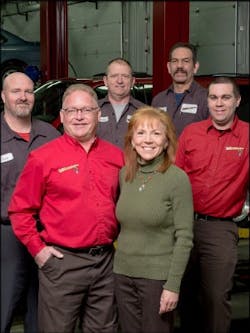No matter who says it, or how they say it, one thing is inevitable in business: mistakes, and plenty of them. The key is to learn from those mistakes; to turn every wrong turn into a new pathway for success.
Ratchet+Wrench spoke with three owners about their biggest mistakes—the accidents, mishaps and all-out failures that not only provided valuable business lessons but also helped to define and shape their shops today.
Too Big, Too Soon
Money wasn’t the reason I went into business. I wanted to be successful. Any kind of failure, well, it was what I was trying to guard against. I didn’t want to admit to failing.
I bought Performance Truck & Automotive in January of 2007, and we had three locations at the time. I wanted a big company. That’s why I chose this one. I saw it for sale, and I thought I could grow it even more. My goal was 10 stores in 10 years.
Boy, did that change.
Performance Truck & Automotive
Montgomery, Ala.
Size: 8,000 square feet
Staff: 12
Monthly Car Count: 550
Annual Revenue: $1.9 million
I was—well, I still am a pretty young fell’er. I had three stores and three managers to keep track of. It was tough.
We were doing OK, though, for a while. I think we were looking at about $2.5 million in annual sales for the three shops, altogether. But in October of ’07, I started to notice a decline in numbers. Sales were slipping. We weren’t making a whole lot of money.
It came to a point where, at the end of the month, our expenses were exceeding our income. We didn’t have money to put into new equipment or training or anything. I was at the point where I was just looking at it and saying, “Hey, I have to cut some expenses.”
I could tell our shops were spread too thin. The volume we were doing—we should’ve had one location, not three. But closing a shop would be failing. That was the way I looked at it, and I couldn’t make that choice.
But, it’s what I had to do.
Basically, I picked our best location and focused on putting everything I had into that one store. We consolidated all of our equipment, invested in new equipment, and with a smaller staff, it was much easier to manage. We started marketing more heavily—direct mail, and things like that—and I worked hard to gain a bunch of fleet accounts. We have well over 180 fleet accounts now. Most are small, but we have a few really big ones.
The Lesson
The bottom line here is that I tried to grow too quickly. I wasn’t realistic about what the company could do. The volume just wasn’t there to have three shops. I was forcing it, and it cost me.
I grew up in a small business; my dad owns a Harley shop. I saw what it took to run a shop, and I knew I could handle it. Running three, in the economic situation we were in, was a totally different animal.
Now we’re growing the right way. We have a better facility with better equipment, and that’s led to better, more qualified employees. In 2012, we did nearly $2 million in sales with 16 less people than we had five years before. Profits are up, and we have money to keep re-investing into what we’re doing. Growth can’t be quick. It’s a long-term thing, and that’s what we’re doing now.
(Nearly) Blown Away
All I saw was a big ball of fire coming right at me, and the next thing I knew, I was on my back in the parking lot. It blew me right under the overhead doors of the shop.
Lash Auto Services Inc.
New Haven, Ind.
Size: 4,000 square feet
Staff: 6
Monthly Car Count: 150
Annual Revenue: $500,000
My whole building was gone, up in flames.
That was Nov. 8, 2010. I was in early that morning, and I figured I would clean the shop floor for the guys. I had the floors all soaked up, and the refrigerator sparked. It ignited the soap, then the building, and it exploded.
I was lucky to have been all right. All I really needed was a new haircut.
That wasn’t my mistake, though; that was an accident. The mistake is what I found out as we sought to rebuild: My insurance wasn’t going to cover it all.
I’d been in business since 1997 with just my wife and I. The goal was to just grow it slowly. Luckily for us, it grew a lot quicker. New Haven is a small town, a suburb of Fort Wayne, and we were starting to do really well for ourselves.
Then, in an instant it was gone.
I was fortunate with the relationships we’d developed with our customers. One was a contractor, and he helped immensely with getting a new building put together. And he had some space in a building he owned that we could set up shop temporarily.
Those were the fortunate parts.
Our experience with insurers wasn’t as good. We had always had really high coverage, ever since we opened. A couple months before the fire, we had switched providers, and I had the understanding that our entire package had transferred over.
I didn’t review it thoroughly. And I was wrong.
Insurance covered part of it—a small part—and we’re still negotiating for the rest. The problem was that our coverage completely changed. Our equipment wasn’t up to date on it, and the value of our building, which I owned, wasn’t correct, either. And it certainly didn’t adjust for the cost of building a new facility under the current building codes in the area.
In the end, we’re in about $300,000 on the new building and another $200,000 in tools and equipment. And that’s not taking into account that we were paying rent on a second facility for a full year while construction was going on, or that we couldn’t produce the same amount of work in the temporary shop because it was smaller. We were probably $100,000 under what we would normally do.
We opened the new shop Nov. 12 of 2012, and we’re slowly climbing back.
The Lesson
Obviously, the whole thing is a learning experience, and we gained some knowledge we wish we didn’t have. But the biggest thing is to always review any policy you have with anybody you might be partners with. Don’t just take them for their word.
Blurred Vision, Stunted Growth
I had a clear vision for where we were going. I had the goals laid out, I had the plan laid out, and I started to put it into place.
But it didn’t work.
The goal was growth. I bought Nelson Tire Inc. from a family friend in 2000, and at the time, it was a two-shop business doing almost entirely tires.
Eric Gill, 42
Nelson Tire Inc.
9 locations in Portland, Ore., area
Size: Range from 5,000 to 20,000 square feet
Staff: 75
Monthly Car Count: 225 (mechanical only; 900 total)
Annual Revenue: $3.25 million (mechanical only; $13 million total)
I knew going into it that tires would be quick, high-dollar profit, but they’re also a commodity. If you’re selling a commodity, you have to differentiate yourself from competition. That’s where the mechanical side came in. Adding additional mechanical services would make us a full-service facility and add extra value to customers. We could gain new tire customers, and turn our tire customers into service customers.
That was the plan for our growth.
With some help and training, I started making the changes to our overall approach. I put in standard operating procedures—everything from how we were going to inspect vehicles to how we would answer phones. And I started encouraging our staff to push the mechanical work. We set up goals for how many oil changes, brake jobs, etc. we were going to do each week and month.
Nothing changed.
We had some modest growth for the next year or two, but employees didn’t seem motivated and the changes just weren’t coming through.
I didn’t get it. I was staring at our numbers and just going, “Why is this going on?” It turned out my employees were asking the same question.
The biggest mistake I made was that I didn’t realize that people wanted to understand the big vision of the company; they wanted to know why we were doing all these things.
The Lesson
I knew a lot about balancing the finances and marketing my business, but I wasn’t good at managing people. It led to bad communication. I was just saying, “I want to do this many more oil changes a month,” but never telling them why we’re looking to do more oil changes.
So, we started holding regular meetings. I tried as hard as I could to explain to them the main goal here was growth, and that if we grew as a company everyone would be better off. We set up different incentive programs to go along with the growth. I realized that if you’re going to reward someone for a marathon, they need to be rewarded every mile.
People got on board after that, and we started to see the changes we wanted to. Mechanical work is now 25 percent of our work mix, and we have nine locations. The goal, eventually, is to have 25 shops, doing a total of $50 million a year, a third of that being mechanical. Everyone understands that now, because we explain it thoroughly.
Changing a culture is hard. People are like water; they’ll follow the path you give them. You have to give them the right path.
Four Common Mistakes That Kill Growth
The goal for every company is to grow, whether that’s in terms of scale, sales or profit. And that’s often where a number of business mistakes come into play.
Randy Moon has more than 20 years of experience in business management, having independently consulted for companies big and small (including a number of auto repair facilities). He highlights the “four classic mistakes” businesses make when trying to grow:
1. Employee Incentives. Most owners still cling to pay rates they’ve used for years, Moon says. Savvy business owners need to be savvy about wages. “Owners often forget that a dollar an hour only costs about $2,000 to $5,000 a year,” he says. “A good technician can drive 20 times that amount of business in sales, and maybe profits.” Bottom line: Pay people what they’re worth. You’ll get back what you put in.
2. Company Structure. Growth shouldn’t be a one-time thing; it needs to be constant, Moon says. Too many shops will keep their existing structure in place even though the company is now operating differently. You need to reinvest in the company to properly handle growth, Moon says. “If service quality falls off, loyal customers will, [too].”
3. Roles. Although similar to structural issues, as a business grows, owners need to evaluate how people’s roles will change—and if people need to be moved to different roles. Too many times, Moon says, he sees family members or close friends in positions they shouldn’t be in as the company moves forward.
4. Managing Employees. Studies show that pay is not the top motivator for most employees, Moon says. It’s about creating an environment that is safe, fun and meaningful, a place employees want to come to each day. “Very few companies provide this kind of environment,” he says.
About the Author

Bryce Evans
Bryce Evans is the vice president of content at 10 Missions Media, overseeing an award-winning team that produces FenderBender, Ratchet+Wrench and NOLN.
